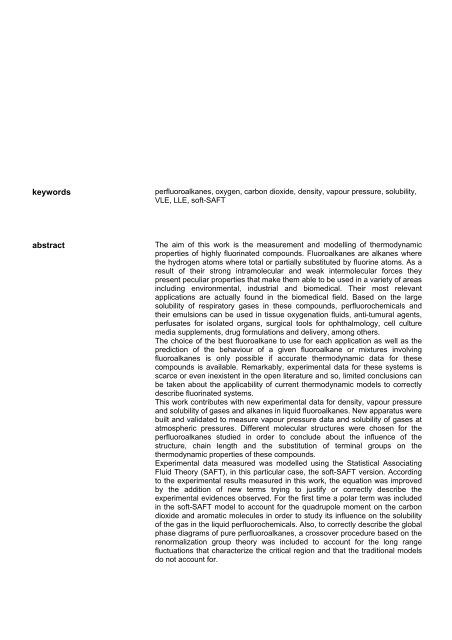n - PATh :.: Process and Product Applied Thermodynamics research ...
n - PATh :.: Process and Product Applied Thermodynamics research ...
n - PATh :.: Process and Product Applied Thermodynamics research ...
Create successful ePaper yourself
Turn your PDF publications into a flip-book with our unique Google optimized e-Paper software.
keywords<br />
abstract<br />
perfluoroalkanes, oxygen, carbon dioxide, density, vapour pressure, solubility,<br />
VLE, LLE, soft-SAFT<br />
The aim of this work is the measurement <strong>and</strong> modelling of thermodynamic<br />
properties of highly fluorinated compounds. Fluoroalkanes are alkanes where<br />
the hydrogen atoms where total or partially substituted by fluorine atoms. As a<br />
result of their strong intramolecular <strong>and</strong> weak intermolecular forces they<br />
present peculiar properties that make them able to be used in a variety of areas<br />
including environmental, industrial <strong>and</strong> biomedical. Their most relevant<br />
applications are actually found in the biomedical field. Based on the large<br />
solubility of respiratory gases in these compounds, perfluorochemicals <strong>and</strong><br />
their emulsions can be used in tissue oxygenation fluids, anti-tumural agents,<br />
perfusates for isolated organs, surgical tools for ophthalmology, cell culture<br />
media supplements, drug formulations <strong>and</strong> delivery, among others.<br />
The choice of the best fluoroalkane to use for each application as well as the<br />
prediction of the behaviour of a given fluoroalkane or mixtures involving<br />
fluoroalkanes is only possible if accurate thermodynamic data for these<br />
compounds is available. Remarkably, experimental data for these systems is<br />
scarce or even inexistent in the open literature <strong>and</strong> so, limited conclusions can<br />
be taken about the applicability of current thermodynamic models to correctly<br />
describe fluorinated systems.<br />
This work contributes with new experimental data for density, vapour pressure<br />
<strong>and</strong> solubility of gases <strong>and</strong> alkanes in liquid fluoroalkanes. New apparatus were<br />
built <strong>and</strong> validated to measure vapour pressure data <strong>and</strong> solubility of gases at<br />
atmospheric pressures. Different molecular structures were chosen for the<br />
perfluoroalkanes studied in order to conclude about the influence of the<br />
structure, chain length <strong>and</strong> the substitution of terminal groups on the<br />
thermodynamic properties of these compounds.<br />
Experimental data measured was modelled using the Statistical Associating<br />
Fluid Theory (SAFT), in this particular case, the soft-SAFT version. According<br />
to the experimental results measured in this work, the equation was improved<br />
by the addition of new terms trying to justify or correctly describe the<br />
experimental evidences observed. For the first time a polar term was included<br />
in the soft-SAFT model to account for the quadrupole moment on the carbon<br />
dioxide <strong>and</strong> aromatic molecules in order to study its influence on the solubility<br />
of the gas in the liquid perfluorochemicals. Also, to correctly describe the global<br />
phase diagrams of pure perfluoroalkanes, a crossover procedure based on the<br />
renormalization group theory was included to account for the long range<br />
fluctuations that characterize the critical region <strong>and</strong> that the traditional models<br />
do not account for.



